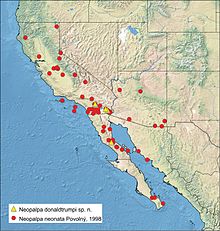Neopalpa donaldtrumpi: Difference between revisions
Lembit Staan (talk | contribs) →Description: rm nn trivia |
Removal itself is a weight issue for a main identifying feature of the species (more on talk). Expanded a bit for male and female genitalia from key. |
||
| Line 45: | Line 45: | ||
| caption2 = Donald Trump |
| caption2 = Donald Trump |
||
}} |
}} |
||
The body of the moth is between 7 and and 11 millimeters in length and the spread of its [[Insect wing|forewings]] is between 6 and 9.2 millimeters. The upper surface of the forewings shows a dark brown costal region with sparse, lighter speckles, the [[Anatomical_terms_of_location#Dorsal_and_ventral|dorsal]] region and discal [[fascia]] are orange yellow to pale buff, the sinuous margin has two or three scallops. The apical area and the fringes are dark brown heavily mottled with lighter suffusion. [[Insect wing|Hindwings]] are pale buff, unmarked and with slightly darker fringe. Its [[Antenna (biology)|antenna]] is about two-thirds of its wingspan and its head is covered with yellowish white scales, which inspired the moth's name.<ref name="Nazari" /><ref name=spiegel /> |
The body of the moth is between 7 and and 11 millimeters in length and the spread of its [[Insect wing|forewings]] is between 6 and 9.2 millimeters. The upper surface of the forewings shows a dark brown costal region with sparse, lighter speckles, the [[Anatomical_terms_of_location#Dorsal_and_ventral|dorsal]] region and discal [[fascia]] are orange yellow to pale buff, the sinuous margin has two or three scallops. The apical area and the fringes are dark brown heavily mottled with lighter suffusion. [[Insect wing|Hindwings]] are pale buff, unmarked and with slightly darker fringe. Its [[Antenna (biology)|antenna]] is about two-thirds of its wingspan and its head is covered with yellowish white scales, which inspired the moth's name.<ref name="Nazari" /><ref name=spiegel /> Compared to the other species in the genus, ''[[Neopalpa neonata|N. neonata]]'', ''N. donaldtrumpi'' male genitalia are less pronounced and female genitalia possess very few fine [[setae]].<ref name="Nazari" /> |
||
==Distribution== |
==Distribution== |
||
Revision as of 19:17, 23 January 2017
| Neopalpa donaldtrumpi | |
|---|---|

| |
| Adult male specimen | |
| Scientific classification | |
| Kingdom: | |
| Phylum: | |
| Class: | |
| Order: | |
| Family: | |
| Genus: | |
| Species: | N. donaldtrumpi
|
| Binomial name | |
| Neopalpa donaldtrumpi Nazari, 2017
| |

| |
| Distribution of N. donaldtrumpi (yellow triangles) | |
Neopalpa donaldtrumpi is a moth species of the genus Neopalpa occurring in Southern California and Northern Mexico. It was first described by Canadian scientist Vazrick Nazari in January 2017. He chose the name because the moth's head cover reminded him of the hair of Donald Trump and he hoped that the name might create some publicity for underappreciated small animals.
Discovery
The genus Neopalpa including the species Neopalpa neonata was first described in 1998 by Dalibor Povolný.[1] Almost two decades later, Vazrick Nazari reviewed the material, including various specimens that had been collected since the first description of the genus, from the Bohart Entomology Museum.[2] He discovered that some of the specimens actually formed a separate new species, which he called Neopalpa donaldtrumpi due to the yellowish-white color of the scales on the top of its head, which reminded him of Donald Trump's hairstyle.[3] He also hoped that the name might provide more publicity to often underappreciated small and rare creatures.[3][4]
Description
The body of the moth is between 7 and and 11 millimeters in length and the spread of its forewings is between 6 and 9.2 millimeters. The upper surface of the forewings shows a dark brown costal region with sparse, lighter speckles, the dorsal region and discal fascia are orange yellow to pale buff, the sinuous margin has two or three scallops. The apical area and the fringes are dark brown heavily mottled with lighter suffusion. Hindwings are pale buff, unmarked and with slightly darker fringe. Its antenna is about two-thirds of its wingspan and its head is covered with yellowish white scales, which inspired the moth's name.[3][4] Compared to the other species in the genus, N. neonata, N. donaldtrumpi male genitalia are less pronounced and female genitalia possess very few fine setae.[3]
Distribution
While the closely related N. neonata occurs throughout much of California, Baja California and Northwest Mexico, N. donaldtrumpi so far has only been established for the Northern half of Baja California and Riverside and Imperial counties in Southern California.[3] Both are twirler moths, known for their propensity to spin in circles on leaves.[5] The moth appears to be evenly distributed through the year, but its host plant and lifespan are not known.[6]
See also
References
- ^ Povolný, Dalibor. "Neopalpa gen. n. and Eurysaccoides gen. n. — two new genera of the tribe Gnorimoschemini from California, with the description of three new species (Lepidoptera, Gelechiidae)". Revista de Lepidopterología. 26. Sociedad Hispano-Luso-Americana de Lepidopterología: 139–146.
- ^ Fitch, Chris (2017-01-18). "Meet the Trump moth". Geographical. Royal Geographical Society. Retrieved 2017-01-20.
- ^ a b c d e Nazari, Vazrick (2017). "Review of Neopalpa Povolný, 1998 with description of a new species from California and Baja California, Mexico (Lepidoptera, Gelechiidae)". ZooKeys. 646: 79. doi:10.3897/zookeys.646.11411.
{{cite journal}}: CS1 maint: unflagged free DOI (link) - ^ a b "Neopalpa donaldtrumpi Motte trägt nun Namen von Donald Trump", Der Spiegel, 18 January 2017 (German)
- ^ Burdick, Alan (January 20, 2017). "The Metaphorical Meaning of a Moth Named after Trump". The New Yorker. Retrieved 23 January 2017.
The genus belongs to a wider family, Gelechiidae, the twirler moths, so called for their habit of spinning in circles on the surface of leaves.
- ^ "Research: Recently described moth named in honour of new U.S. president". BirdGuides. 20 January 2017. Retrieved 23 January 2017.
External links
 Media related to Neopalpa donaldtrumpi at Wikimedia Commons
Media related to Neopalpa donaldtrumpi at Wikimedia Commons


